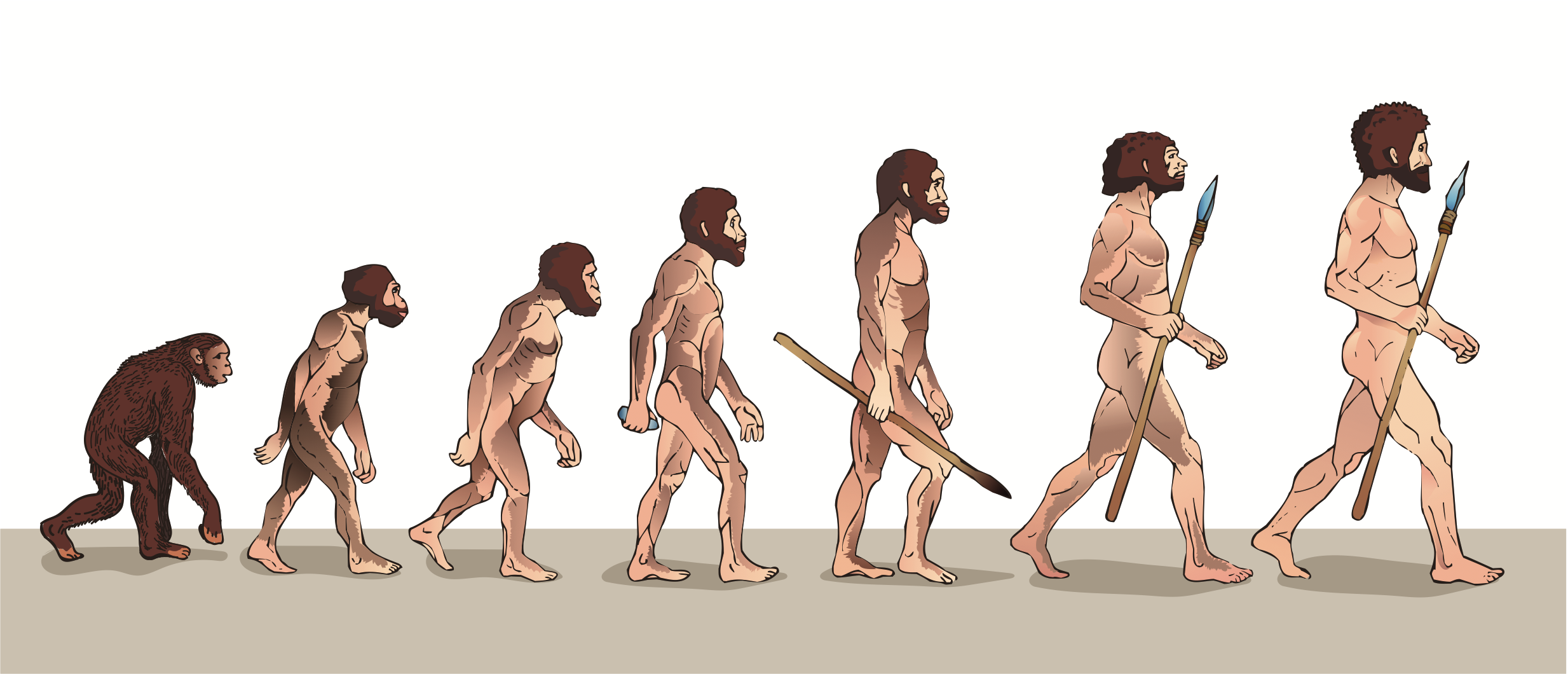©Copyright 2018 GEOSCIENCE RESEARCH INSTITUTE
11060 Campus Street • Loma Linda, California 92350 • 909-558-4548


The iconic cartoon, “The March of Progress” is “wrong.” Image via Usagi-P / Shutterstock
The origin of humans is perhaps the most important issue for creationists dealing with evolutionary theory. The conventional evolutionary view is that modern humans are the descendants of a series of fossil forms, the most recent of which is Homo erectus or similar forms. Homo erectus is supposedly the descendant of one of the australopithecines, perhaps through an intermediate form such as “Homo habilis.”
The significance of the topic and the rarity of the applicable fossils makes for sensationalism. This is evident in the publicity given to the discovery of each new partial skull or femur, and the frequent statement that the new discovery will re-write the history of human ancestry. Some recent discoveries illustrate these points and add important information to the discussion.
In South Africa, skeletal material from three distinct species of fossil hominids have been reported from the same area, in sediments thought to be from the same time period.[1] The three species are Homo erectus, Paranthropus robustus, and Australopithecus sediba. This is an interesting find, because A. sediba has been proposed to be an ancestor of Homo erectus. This discovery makes that idea difficult to accept because there are no known A. sediba dated older than this Homo erectus. Once again, the proposed evolutionary ancestry of Homo erectus has been refuted.
The ape-like nature of Australopithecus was again confirmed by a new report[2] on its brain organization, based on an endocast of a skull of A. afarensis. Eight crania were studied, including two infants, and brain organization was compared to estimates of age at death. The researchers found no features that show a trend to human brain organization. Thus, these Australopithecus brains were not intermediate between humans and other apes such as chimpanzees.
In another report[3], two Homo erectus skulls were found in Ethiopia in close association with two distinct types of stone tool technologies. Both Oldowan and Acheulian tools were found in the same locations. This was unexpected because the simpler Oldowan tools were considered older than Acheulian tools and the two types have been interpreted as an evolutionary sequence in human development and technology. Finding the two types together in two different locations suggests a possible alternative interpretation, that the simpler Oldowan tools and the more carefully crafted Acheulian tools might have been produced for different purposes, or in different circumstances, and not due to differences in level of intelligence.
The lack of convincing ancestral links connecting humans with non-humans such as Australopithecus was discussed in a recent editorial from the Discovery Institute.[4] The conclusion was that humans are separated from other creatures by significant gaps, both morphologically and intellectually, and the evidence does not support the common claim of gradual evolutionary development of humans. Here are two quotations from well-known paleoanthropologists, as cited in the editorial.
“We, like many others, interpret the anatomical evidence to show that early H. sapiens was significantly and dramatically different from earlier and penecontemporary australopithecines21 in virtually every element of its skeleton and every remnant of its behavior.”[5]
And another:
“We differ from our closest known relatives in numerous features of the skull and of the postcranial skeleton, in important features of brain growth, and almost certainly in critical features of internal brain organization as well. These differences exist on an unusual scale. At least to the human eye, most primate species don’t differ very much from their closest relatives. Differences tend to be largely in external features such as coat color, or ear size, or even just in vocalizations; and variations in bony structure tend to be minor. In contrast, and even allowing for the poor record we have of our closest extinct kin, Homo sapiens appears as distinctive and unprecedented. Still, we evidently came by our unusual anatomical structure and capacities very recently: There is certainly no evidence to support the notion that we gradually became what we inherently are over an extended period, in either the physical or the intellectual sense.”[6] [Emphasis added in the cited editorial.]
The iconic cartoon of human evolution, called “The March of Progress” (see figure above) is being rejected for its depiction of a steady, gradual evolution of humans from apes.[7] The evolutionary hypothesis of human origins is still maintained, but the evidence has forced the recognition that there is no convincing case of any specific fossil lineage leading to the genus Homo.
The striking distinction between humans and other creatures, including apes, is being interpreted as indicating an abrupt origin for humans. This is consistent with the creationist position that humans and apes are separately created lineages.
James Gibson, PhD
Geoscience Research Institute
References
[1] Herries, AIR, et al. 2020. Contemporaneity of Australopithecus, Paranthropus, and early Homo erectus in South Africa. Science 368(6486), eaaw7293. DOI: 10.1126/science.aaw7293
[2] Gunz, P., et al. 2020. Australopithecus afarensis endocasts suggest ape-like brain organization and prolonged brain growth. Scientific Advances 6:eeaz4729 April 2020.
[3] Semaw, S, et al. 2020. Co-occurrence of Acheulian and Oldowan artifact with Homo erectus cranial fossils from Gona, Afar, Ethiopia. Science Advances 2000;6:eeaw4694; 6 March 2020.
[4] Lönnig, W-E. 2020. Neo-Darwinism and the big bang of man’s origin. Downloaded 26 February 2020 from https://evolutionnews.org/2020/02/neo-darwinism-and-the-big-bang-of-mans-origin/.
[5] Hawks J, K Hunley, S-H Lee, M Wolpoff. 2000. Population bottlenecks and Pleistocene human evolution. Molecular Biology and Evolution 17(1):2-22; p 3.
[6] Ian Tattersall, Masters of the Planet: The Search for our Human Origins (New York: Palgrave MacMillan, 2012, and New York: St. Martin’s Griffin, 2013), 207.
[7] Paps J and C Guijarro-Clarke. 2020. Evolution: that famous “march of progress” image is just wrong. The Conversation March 2, 2020. Downloaded 8 April 2020.